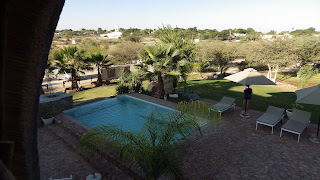 |
| Looking like grazing land |
 |
| Yes, those are cones |
 |
| The two leaves growing from the central core are clearly seen |
 |
| There were lots of these |
 |
| This guy is less than 2" long from nose to tail |
 |
| A skink, I think |
 |
| A big log |
 |
| Stone that looks just like a tree |
 |
| Over 40 m tall |
From here, we headed back to Khorixas, then north to Kamininjab, passing F Roads that I mentioned a few posts back.
We did a brief roadside rest stop, and I found a beautiful iridescent red damselfly. We don’t have red damselflies where I live.
 |
| One of 128 species of dragonflies in Namibia |
Did you read it? I thought not.
So the Himba are one of ~8 tribes that lived in the Angola-Namibia area pre-European settlement, and are of interest for a few reasons, mostly associated with their lifestyle, which many would consider “weird”. For instance
- Women don’t ever bathe in water; they cover themselves in a mix of butterfat (extracted from their cow’s milk) and ochre, and “cleanse” themselves daily in 2 hr pre-dawn smoke bath.
- They have a specific treatment for their hair involving butterfat and ochre, too.
- The Himba don’t generally wear any clothes, though not being stupid, if they’re sitting on the ground (which they do a lot) they wear leather “skirts”.
- Their front 4 lower teeth get knocked out in a big ceremony when they turn 12 or so, helping with pronouncing their language. This, apparently, hurts, and is memorable.
- Women are “bought” for marriage with cows. Men can have as many wives as he can afford cows to give away, and most have at least 2 wives.
- Hairstyles are a function of age, as are necklaces.
- Women cannot show their ankles, and what they wear around their ankles is a function of how old they are, whether they are married, and how many children they have.
- Men aren’t allowed on the right side of a hut; that side is the kitchen and that’s a woman’s duty.
- The huts are made of mopane tree branches covered in mud made from cow dung and termite mounds, as is the floor.
So they are interesting to tourists because we think they’re strange, though all it really is, is a set of traditions adopted about living in a desert.
The village we visited is actually mostly an orphanage with a school; something like 20 women, 50 kids but only 6 men. Accordingly, there are kids running everywhere. Many on our truck brought the village school supplies, like pens and coloured pencils and notebooks and stuff like that. Not every child goes to school; it's optional. There are mixed feelings among the Himba of schools; once a child starts attending school, there's a virtual certainty of the loss of their traditional lifestyle.
 |
| The school |
 |
| The school's interior. There are only 7 students |
 |
| Kids are kids the world over. Note the pants |
 |
| Traditional kid |
 |
| A traditional greeting includes shaking hands |
 |
| A traditional hairstyle |
 |
| The huts surrounding the corral |
 |
| It's communal childrearing |
 |
| Maize porridge, the universal food of southern Africa |
 |
| A traditional family |
 |
| Men on the right, women on the left |
 |
| Building the incense fire |
 |
| Adding her own special blend of herbs and resins |
 |
| The smoke rises through her hair |
 |
| A different kind of shampooing |
 |
| Shopping time! |
 |
| They actually have nice stuff |
 |
| Bracelets, plus leftover ochre from shaking hands |
Still, the Himba (and there are about 50,000) are co-existing just fine with the rest of the world, maintaining their lifestyle, going grocery shopping, selling goods at markets, and even protesting proposed hydroelectric dams that infringe on their traditional lifestyle lands. Given their lifestyle, and how many of their traditions (oh, like being naked) are societally unacceptable in lots of places, that's impressive and demonstrates the resiliency of those who live in the harshest of places on earth.
By the way, technically, it's the Himba people. Individually, each is OmuHimba, and in a group, they are OvaHimba.
Home for tonight is in Outjo, in yet another in the list of spectacular places to stay.
 |
| The lodge |
 |
| The grounds |
 |
| The bar and restaurant |
 |
| The (cold) pool |
 |
| They're all of 1 m tall |
 |
| Big eyes, since they're a prey of lots of critters |
 |
| Even pythons will go after them |
 |
| Perils of being small |
 |
| Wary |
=================
Today’s African Travel Tip: Nuts
So one of the most popular items to try to sell to tourists is a nut the size of a large marble on the end of a leather ring. Not sure what the nut is (some kind of native palm tree, and the nuts aren’t good for anything except baboons), but it’s easy to carve. It’s brown on the outside and white on the inside. Sometimes they're just carved nuts with images of trees or elephants or rhinos. But they can be personalized. The pitch goes like this…
Sales guy approaches you and cheerily engages you in conversation. Very quickly, he asks you his name, which he writes on his arm or hand with a small tool to make sure he understands you. He disappears, and less than 1 min later, reappears with your name carved in the nut. You, of course, buy it, as it is individualized, and because if you don’t buy it, the nut and his hard work are wasted.
Carved nuts will cost you N$20-$N70, and are ~N$0.20 to make. Bargain hard.



No comments:
Post a Comment